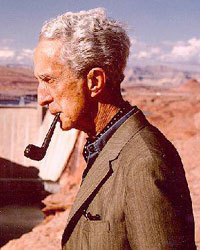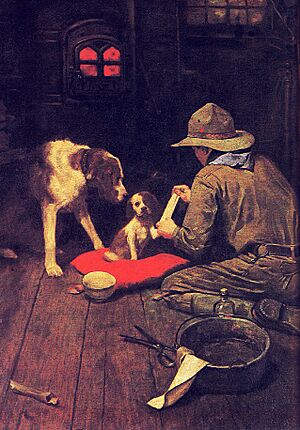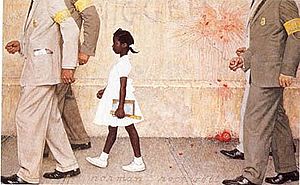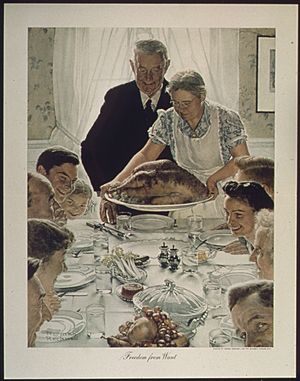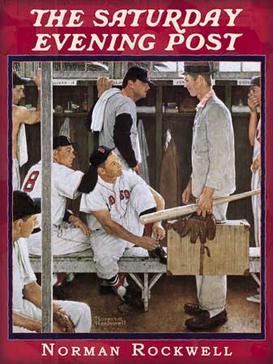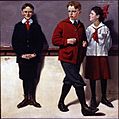Norman Rockwell facts for kids
Quick facts for kids
Norman Rockwell
|
|
|---|---|
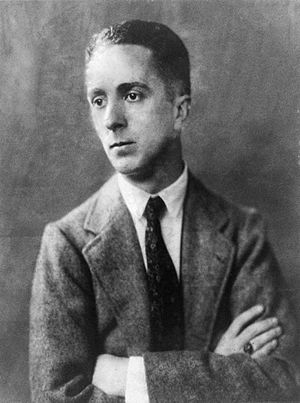
Norman Rockwell, c. 1921
|
|
| Born |
Norman Percevel Rockwell
February 3, 1894 New York City, New York, U.S.
|
| Died | November 8, 1978 (aged 84) Stockbridge, Massachusetts, U.S.
|
| Nationality | American |
| Education | National Academy of Design Art Students League |
| Known for | Painting, illustration |
|
Notable work
|
Willie Gillis Rosie the Riveter Four Freedoms The Problem We All Live With |
| Awards | Presidential Medal of Freedom |
Norman Rockwell (born February 3, 1894 – died November 8, 1978) was a famous American painter and illustrator. He was born in New York City. For 40 years, Rockwell created the cover pictures for The Saturday Evening Post magazine. He passed away in Stockbridge, Massachusetts, from a lung condition called emphysema. Today, the Norman Rockwell Museum in Stockbridge has many of his artworks.
Rockwell is well known for his paintings called the Four Freedoms. These paintings were inspired by President Franklin D. Roosevelt's ideas. The four paintings are: Freedom of Speech, Freedom of Worship, Freedom from Want, and Freedom from Fear.
Norman Rockwell's Life Story
Growing Up and Art School
Norman Rockwell was born in New York City on February 3, 1894. His parents were Jarvis Waring and Ann Mary Rockwell. He had one brother named Jarvis.
Norman loved art from a young age. At 14, he left high school to study art at the Chase Art School. He then went to the National Academy of Design and later the Art Students League. There, he learned from teachers like Thomas Fogarty and George Bridgman. His first artworks were for children's magazines, such as St. Nicholas Magazine and Boys' Life, a publication for the Boy Scouts of America.
When he was 18, Rockwell got his first big job. He illustrated a book called Tell Me Why: Stories about Mother Nature in 1912.
In 1913, at 19, Rockwell became the art editor for Boys' Life magazine. This magazine was published by the Boy Scouts of America. He worked there for three years. During this time, he painted several covers. His first published magazine cover was Scout at Ship's Wheel, which appeared in the September 1913 issue of Boys' Life.
Starting His Career and World War I
During the First World War, Rockwell tried to join the U.S. Navy. He was very tall (6 feet) but a bit too light. To gain weight, he ate a lot of bananas, liquids, and donuts. He weighed enough the next day and was able to join. However, he became a military artist and did not fight in any battles.
When he was 21, Rockwell moved to New Rochelle, New York. He shared a studio with a cartoonist named Clyde Forsythe. Forsythe worked for The Saturday Evening Post. With Forsythe's help, Norman sent his first cover painting to the Post in 1916. It was called Mother's Day Off and was published on May 20.
Rockwell had great success with the Post. He published eight covers in his first year alone. Over 47 years, Norman Rockwell created a total of 321 original covers for The Saturday Evening Post. His success also led to covers for other popular magazines like The Literary Digest, The Country Gentleman, and Life Magazine.
Family Life and Moving Homes
In 1916, Rockwell married his first wife, Irene O'Connor. Irene was the model for his painting Mother Tucking Children into Bed, which was on the cover of The Literary Digest in 1921. They divorced in 1930.
Soon after, he married Mary Barstow, a schoolteacher. They had three sons: Jarvis Waring, Thomas Rhodes, and Peter Barstow. The family lived in New Rochelle, New York. In 1939, the Rockwell family moved to Arlington, Vermont. Here, his art began to show scenes of small-town life.
In 1953, the family moved to Stockbridge, Massachusetts. Sadly, Mary Barstow Rockwell passed away unexpectedly six years later. In 1961, Rockwell married Molly Punderson, who was a retired teacher.
Art During World War II
In 1943, during the Second World War, Rockwell painted his famous Four Freedoms series. He worked on these paintings for seven months and even lost weight because he worked so hard! The series was inspired by a speech from President Franklin D. Roosevelt. In his speech, Roosevelt talked about four important principles for everyone's rights: Freedom from Want, Freedom of Speech, Freedom to Worship, and Freedom from Fear.
The Saturday Evening Post published these paintings in 1943. The U.S. Treasury Department then used the original paintings to help sell war bonds. They showed the paintings in 16 cities across the country. Rockwell himself thought "Freedom of Speech" was the best of the four. That same year, a fire in his studio destroyed many of his original paintings and art supplies.
In the late 1940s, Norman Rockwell spent winters as an artist at Otis College of Art and Design. Sometimes, students there would pose for his Saturday Evening Post covers. In 1958, his wife Mary died. Rockwell took a break from painting to grieve. During this time, he and his son Thomas wrote his autobiography, My Adventures as an Illustrator. It was published in 1960. The Post printed parts of this book, including Rockwell's famous Triple Self-Portrait.
Later Years and Important Recognition
Rockwell married his third wife, Molly Punderson, in 1961. His last painting for the Post was published in 1963. This ended a long partnership that included 322 cover paintings. For the next 10 years, he painted for Look magazine. His work during this time showed his interest in important topics like civil rights, poverty, and space exploration.
Throughout his long career, he painted portraits of Presidents Eisenhower, Kennedy, Johnson, and Nixon. He also painted leaders from other countries. One of his last works was a portrait of the singer Judy Garland in 1969.
With Rockwell's help, a special collection of 574 of his original paintings and drawings was created near his home in Stockbridge. This museum is still open today. In 1977, Rockwell received the Presidential Medal of Freedom. This is the highest award a civilian can receive in the United States. He received it for his "vivid and affectionate portraits of our country."
Norman Rockwell passed away on November 8, 1978, at the age of 84. He died in Stockbridge, Massachusetts.
Norman Rockwell's Artworks
Norman Rockwell created over 4,000 original artworks. Many of these are now in museums or private collections. He also illustrated more than 40 books, including Tom Sawyer and Huckleberry Finn.
From 1925 to 1976, he made annual contributions for the Boy Scouts' calendars. He also created popular "Four Seasons" illustrations for Brown & Bigelow, which were published for 17 years starting in 1947. Rockwell's art also appeared on posters, sheet music, stamps, and even playing cards. He also painted murals, like "Yankee Doodle Dandy" in 1936.
In 1969, to celebrate Rockwell's 75th birthday, the Boy Scouts of America asked him to pose for the calendar illustration that year, called Beyond the Easel.
During his lifetime, some art critics did not consider Rockwell a "serious painter." They often called him an "illustrator" instead of an artist. Rockwell himself did not mind this title. Many of his Saturday Evening Post covers showed an idealized or sentimental view of American life. This led to the term "Rockwellesque" to describe art that is overly sweet or nostalgic.
However, in his later years, Rockwell started to get more attention as a painter. He began to paint more serious subjects, such as a series about racism for Look magazine. One important example of this is The Problem We All Live With. This painting shows a young African American girl, Ruby Bridges, walking to school. She is protected by federal marshals, and behind her is a wall with racist graffiti. This painting dealt with the important issue of school integration.
In 1999, art critic Peter Schjeldahl said, “Rockwell is terrific. It’s become too boring to pretend he isn’t.”
Rockwell's work has been shown in major art museums, including the Solomon R. Guggenheim Museum in 2001. In 2006, his painting Breaking Home Ties sold for $15.4 million at an auction.
Rockwell's Influence in Movies
Norman Rockwell's art has inspired many movies and TV shows:
- In the film Empire of the Sun, a scene where a boy is put to bed by his parents was inspired by a Rockwell painting.
- The 1994 film Forrest Gump includes a scene in a school that looks like Rockwell's "Girl with Black Eye."
- The end credits of the film Lilo & Stitch show a funny version of Rockwell's Thanksgiving illustration.
- The 1988 film Funny Farm features a plan where people try to make a town look like a Norman Rockwell painting.
- In the film The Polar Express, one of Rockwell's Saturday Evening Post covers, The Discovery (Boy Discovering Santa Suit), appears.
- Film directors George Lucas and Steven Spielberg own original Rockwell artworks. Rockwell is also a character in an episode of Lucas’ Young Indiana Jones Chronicles.
- A Thanksgiving dinner scene in the 2007 film American Gangster looks like Rockwell's painting "Freedom from Want."
Famous Paintings by Norman Rockwell
Here are some of Norman Rockwell's well-known works:
- Scout at Ship's Wheel (1913)
- Boy and Baby Carriage (1916) (His first Saturday Evening Post cover)
- Circus Barker and Strongman (1916)
- Tain't You (1917) (His first Life Magazine cover)
- Mother Tucking Children into Bed (1921)
- No Swimming (1921)
- Doctor and Doll (1929)
- The Four Freedoms (1943)
- Freedom of Speech (1943)
- Freedom to Worship (1943)
- Freedom from Want (1943)
- Freedom from Fear (1943)
- Rosie the Riveter (1943)
- Going and Coming (1947)
- Saying Grace (1951)
- Girl at Mirror (1954)
- Breaking Home Ties (1954)
- Triple Self-Portrait (1960)
- Golden Rule (1961)
- The Problem We All Live With (1964)
- Southern Justice (Murder in Mississippi) (1965)
- New Kids in the Neighborhood (1967)
- The Rookie (1957)
Images for kids
-
Freedom of Speech, 1943
-
Rockwell painting actor Mike Connors's portrait on the set of Stagecoach (1966).
See also
 In Spanish: Norman Rockwell para niños
In Spanish: Norman Rockwell para niños





